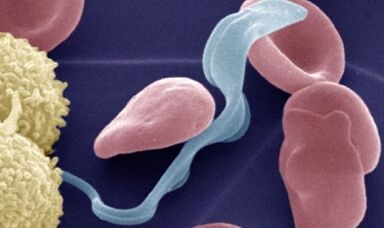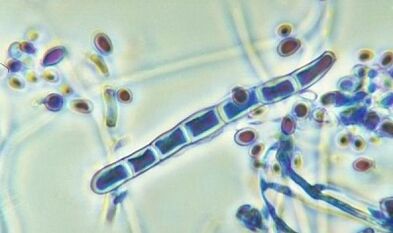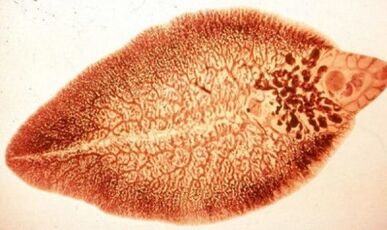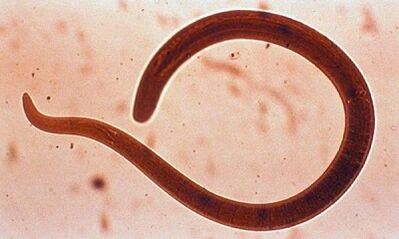Human parasites can live in all organ systems. The vital activity of helminths can be a condition for the development of cancer, and microscopic fungi and ticks cause allergies.
At least 300 parasitic species can live in the human body, including bacteria, viruses, protozoa, microscopic fungi, helminths (parasitic worms), and representatives of various arthropods. These organisms not only consume food assimilated by the host, but also poison it with the products of their vital activities. According to modern medical canons, the term "parasite" does not apply to prenuclear (prokaryotic) organisms: bacteria and viruses. Characterizes protozoa, fungi, worms, arthropods living only in the body of the host.
Microparasites

Human and animal organisms are a fertile environment for the life of microscopic fungi, as well as protozoa. Invisible to the naked eye, it damages the skin and internal organs.
Parasitic protozoa
An infection caused by a protozoan is called a protozoal. Such diseases are widespread in the tropics and temperate latitudes. About 50 species of protozoa are parasitized in human organs and tissues. They can be transmitted through sexual contact, food or insect bites.
Giardiasis is very common. Up to 40% of children and 10% of adults have this pathology. The favorite habitat for Lamblia is the small intestine. The disease may be accompanied by digestive disorders, allergic reactions, although it is often asymptomatic. The pathogen is transmitted through food - unboiled water and contaminated food.
According to various sources, 30-50% of the world's population is infected with toxoplasmosis. The pathogen often lives in the host's body without any clinical manifestations. Toxoplasma poses the greatest danger to pregnant women: it causes fetal death or serious birth defects. Infection occurs through contact with domestic mammals (cats, rabbits, rodents) and consumption of uncooked meat.
The most common sexually transmitted infection is protozoal. This is trichomoniasis. Every year, more than 150 million people are infected worldwide. Manifestations of the disease are determined by which organs are affected. In women, Trichomonas lives in the vagina and is accompanied by urethritis. In men, protozoan prostatitis affects the seminal vesicles, causing prostatitis in severe cases, although most infections are asymptomatic.
Diseases such as malaria, leishmaniasis, Chagas' disease, and sleeping sickness are widespread in the tropics. Their causative agents are plasmodia, leishmaniasis and trypanosomes, respectively. Parasites are carried by blood-sucking insects: mosquitoes, tsetse flies, three-atomized insects. By biting sick animals or humans, they acquire and spread the causative agents of these diseases.
Parasitic fungi

About 100 species of mushrooms are known to be extremely dangerous to humans. Their optimal living space is the hot and humid areas of the body, such as the interstitial spaces. However, these organisms can also infect the skin and other parts of the human body.
Fungi of the species Trichophyton, Microsporum, Epidermophyton cause dermatomycosis: ringworm and pityriasis versicolor, foot injuries, scalp, rarely mucous membranes. The causative agents of these diseases can be transmitted to humans from animals or patients. In severe cases, bacterial infections are associated with dermatomycosis.
Mold fungi and their spores are less harmful to humans. They cause the following diseases:
- penicellosis;
- mucosa;
- aspergillosis.
These pathologies, without exception, are characterized by inflammation of all parts of the respiratory tract, otitis media and various allergic reactions. In severe cases, parasitic fungi cause pneumonia along with bronchial asthma. People with weakened immunity and chronic diseases are most susceptible to fungal infections.
Helminths
The favorite habitat for parasitic worms is the digestive system of humans and animals, which feed on food, bile and blood digested by the host. All helminths belong to the following classes:
- roundworms (nematodes);
- flatworms (tapeworms and larynx).
Straight parasitic worms
Eggs and larvae of trematodes (flatworms) enter the human body most often with raw water, unwashed greens, sufficiently heated meat and fish. This is:
- liver;
- China
- giant;
- lanceolate flukes;
- cat mixture.

Sometimes a person is infected by direct contact: the larvae of tropical parasites of schistosomes pierce the skin of people swimming in clean water, and then enter the bloodstream, where they live and feed on erythrocytes.
Many trematodes cause diseases - trematodes, affecting the liver, gallbladder and ducts of these organs. The environment for the life of a pulmonary lesion is the muscles, subcutaneous adipose tissue, brain, but above all the lungs. The disease caused by this helminth is called paragonimiasis. The small trematode metagonium lives in the small intestine and causes metagonimosis.
Flukes are small - straight, leaf-shaped stems no more than 10 cm - however, the consequences of remaining in the body of animals and humans are fatal. Long-term parasitism of these helminths can lead to the development of cancer, cirrhosis and gallstones.
Unlike trematodes, the body of tapeworms (cestodes) can reach ten meters in length. The main route of transmission of cestodes is food. These helminths enter the human body through uncooked meat and fish. The main environment for the development of cestodes is the small intestine, where adult worms live, and the larval forms live in the parenchymal organs (liver, lungs, spleen).
The most common of all ribbons:
- the bull formed a ribbon;
- echinococcus;
- wide ribbon;
- pig tapeworm;
- alveococcus.
Round parasitic worms
Diseases caused by parasitic roundworms - nematodes - rank first among all helminthiases in terms of frequency of development. Most adult parasites live in the intestines, but at certain stages of their lives they can migrate to the muscles, lungs, heart and esophagus. The following nematodes are common in the human population:

- pinworms;
- roundworm;
- toxocars;
- Trichinella;
- hook worms;
- Strongilids.
The eggs and larvae of roundworms enter the human body through food and water. Nematodes such as hookworm and stronylid enter the host's body. These helminths are mainly found in the tropics.
Everywhere nematodes are pinworms, roundworms and toxocaras. First, it affects children the most and causes enterobiasis - the most common helminthiasis. Dogs are carriers of Toxocara, although these nematodes can also infect humans. Roundworms live in humans and are not dangerous to most animals except pigs.
Arthropod parasites
Cestodes, trematodes and parasitic nematodes are adapted to live in the internal organs of their owners. In contrast, most parasitic arthropods live on the surface of the body. Often, a person is infected with lice and ticks, which cause demodicosis and itching. These parasites are dangerous because they carry the pathogenic bacteria and rickettsiae that cause fever, typhus, and relapsed fever.
Lice drink human blood and parasitic ticks live on human skin. Itching eats the passages inside the itch, demodex lives in the hair follicles and ducts of the sebaceous glands. The vital activity of these parasites causes allergies, accompanied by redness and itching of the skin.
The world we live in is developing rapidly, living standards are constantly rising, and today many people think that parasitic diseases are spreading to the inhabitants of third world countries. However, population migration leads to the spread of such pathologies beyond natural foci. In this regard, it is important to remember the basic rules of hygiene that will help prevent infection.
























